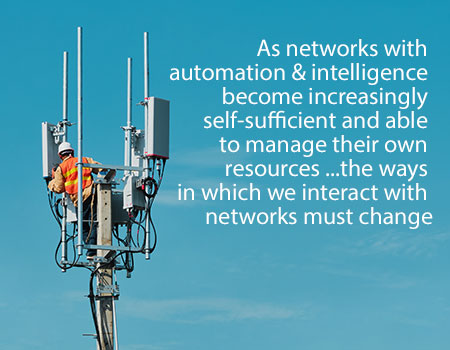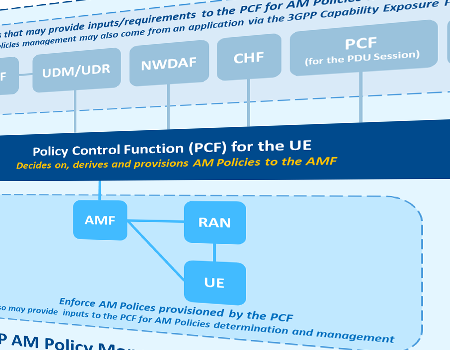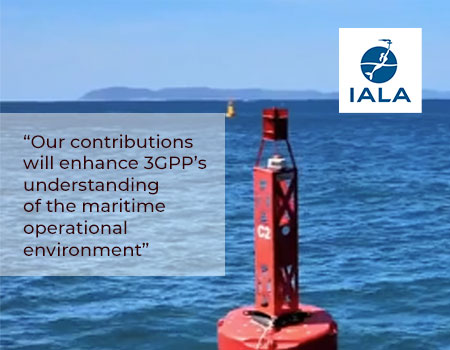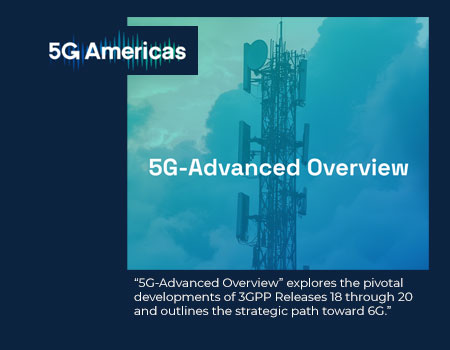by Younsun Kim (RAN1 Chair), Xiaodong Xu and David Mazzarese (RAN1 Vice-Chairs)
First published Nov 2023, in Highlights Issue 07
In December 2021, RAN#94-e endorsed the Release 18 work/study item package. It is the first release of 5G-Advanced – the next evolutionary step for 5G - bringing more capabilities to enable wider use cases and to enhance radio performance to a new level.
RAN1 was tasked with 17 topics over a period of 18 months starting from Q2 of 2022 until Q3 of 2023. Some of these topics were enhancements to existing RAN1 features (e.g. MIMO, coverage enhancement, RedCap) while some were relatively new to the group (e.g. AI/ML, network energy savings, duplex evolution, low power wake up signal). This article introduces some of the Release 18 (Rel-18) work/study items that RAN1 worked on.
1. MIMO Evolution
Rel-18 MIMO continues the enhancement on multi-antenna technology which has been a key component of NR since Release 15, focusing on 4 key areas: Channel State Information (CSI), multi-Transmission and Reception Points (TRP), uplink and reference signals. CSI for high/medium UE velocities and coherent-Joint Transmission (JT). Uplink was enhanced to facilitate multi-panel uplink transmission and up to rank 8 transmission. To better support multi-TRP deployments, unified Transmission Configuration Indicator (TCI) framework which was introduced in Rel-17 for single-TRP use case was expanded to multi-TRP use case and two TAs are supported. Uplink/downlink DeModulation Reference Signal (DMRS) was enhanced to support up to 24 orthogonal ports for MU-MIMO while Sounding Reference Signal (SRS) gets better randomize interference among different TRPs.
2. AI/ML for NR air interface
Rel-18 was the first release in which Artificial Intelligence (AI) and Machine Learning (ML) was studied in RAN1 and despite the potential for a large amount of RAN1 work, the study focused on only three representative use cases: CSI feedback, beam management, and positioning. For each use case, RAN1 studied the benefits of augmenting the air interface with features enabling AI/ML based algorithms for enhancing performance and/or reducing overhead. In addition, extensive study was done on the AI/ML framework that includes defining stages of AI/ML related algorithms, various levels of collaboration between UE and gNB, lifecycle management, and necessary dataset(s). The RAN1 study was extended for an extra quarter to ensure proper study on all three Rel-18 use cases. The work will lay the foundation for future normative work on AI/ML and for additional studies on other use cases.
3. Evolution of Duplex Operation
The study on duplex evolution focused on subband full duplex and potential enhancements for dynamic/flexible TDD. RAN1 was tasked to identify possible specification enhancements to enable the duplex schemes and evaluate the schemes in terms of feasibility and performance. Solutions to address inter-gNB and inter-UE cross link interference were studied and evaluated. In addition, the impact of the duplex schemes on legacy operation assuming their co-existence in co-channel and adjacent channels was evaluated.
4. Sidelink Evolution
The support for NR sidelink introduced in Release 16 primarily targeted communications between/with vehicles for advanced V2X applications, as a complement to LTE-based V2X. Enhancements for power savings and inter-UE coordination for resource allocation were introduced in Release 17. Owing to the growing interest on D2D for commercial use cases, and recognizing that large bandwidths enabling very high data rates can be found in unlicensed spectrum, RAN1 was tasked to specify the support for sidelink in unlicensed spectrum, targeting FR1 unlicensed bands (n46 and n96/n102), i.e. 5 GHz and 6 GHz unlicensed bands, in accordance with the latest regulations. Rel-18 also introduced the support for sidelink carrier aggregation for ITS band n47, as well as mechanism(s) for co-channel coexistence for LTE sidelink and NR sidelink, with both semi-static and dynamic resource pool sharing.
5. Expanded and Improved NR Positioning
Positioning solutions for NR were introduced in Release 16 and enhanced in Release 17. Expansion and improvements to the NR positioning solutions started with a study item in Rel-18, and was followed by a work item. RAN1 introduced the support for positioning over sidelink, i.e. positioning or ranging between two UEs (smartphones or vehicles). Additionally, RAN1 introduced the support for carrier-phase based positioning, increasing accuracy of positioning methods to centimeter level. Support for Low-Power High-Accuracy Positioning (LPHAP) was also introduced with UL and DL+UL positioning for UEs in RRC Inactive state. Increased positioning accuracy was also made possible for RedCap UEs by allowing frequency hopping beyond the maximum RedCap UE bandwidth for reception of DL PRS and transmission of UL SRS for positioning. Finally, RAN1 specified bandwidth aggregation for positioning measurements across up to three intra-band contiguous carriers.
6. Network Energy Savings for NR
Rel-18 network energy savings started with a study item and was followed by a work item. During the study item, RAN1 defined a base station energy consumption model along with necessary evaluation methodology and KPIs. Using the model and evaluation methodology, RAN1 studied and evaluated various techniques in time, frequency, spatial, and power domain. Based on the outcome of the study item, during the work item phase, RAN1 specified enhancement for network energy savings in spatial/power domain and enhancement on cell DTX/DRX.
7. NTN Enhancements
Support for non-terrestrial networks was introduced into 3GPP specifications in Release 17 for eMBB using NR (aka NR NTN) and for Internet of Things using LTE (aka IoT NTN), for transparent payload based GSO and NGSO network scenarios addressing UEs with Global Navigation Satellite System (GNSS) capability. For Rel-18 NR NTN, RAN1 was tasked to specify uplink coverage enhancements for commercial smartphones with -5.5 dBi antenna gain and 3 dB polarization loss, leading to the specification of repetitions for PUCCH for Msg4 HARQ-ACK, and enabling the support for DMRS bundling for PUSCH in NTN scenarios. For IoT NTN, RAN1 specified a mechanism allowing the network to disable HARQ feedback in order to mitigate the impact of HARQ stalling on UE data rates. RAN1 also specified improved GNSS operations during long connection times and for reduced power consumption.
8. Further NR Mobility Enhancements
Rel-18 mobility enhancements was introduced to reduce the latency, overhead, and interruption time of L3 based approach in legacy releases. To that end, mechanisms and procedures of L1/L2 based inter-cell mobility were specified in Rel-18. Compared to legacy releases, the latency required for measurements has been significantly reduced. Furthermore, the handover procedure has been simplified and does not require a random access procedure to the target cell. Rel-18 mobility enhancements are applicable to diverse mobility scenarios such as intra/inter-frequency mobility, FR1/FR2 mobility, and synchronized/non-synchronized cells. To enable L1/L2 based mobility, non-serving cell beam management and non-serving cell TA acquisition were specified in Rel-18.
9. Low-Power Wake-Up Signal and Receiver for NR
The study item focused on evaluating the feasibility and benefit of utilizing low-power wake-up signal (LP-WUS) for UE power consumption reduction. RAN1 was tasked to define the evaluation methodology, study low-power wake-up receiver architectures, and study necessary wake-up signal designs and procedures. RAN1 evaluated potential UE power saving gains compared to the existing UE power saving mechanisms, network coverage/capacity/resource overhead, as well as latency impact for different LP-WUS waveform alternatives.
10. Network Controlled Repeaters
Rel-18 Network Controlled Repeaters (NCRs) started with a study item and was followed by a work item. An NCR is an inband RF repeater used for extension of network coverage on FR1 and FR2. During the study item, RAN1 focus on identifying which of the potential side control information would be necessary for NCRs. Based on the outcome of the study item, during the work item phase, RAN1 specified side control information for beamforming, UL-DL TDD operation, and ON-OFF information.
In addition to the 10 topics mentioned above, RAN1 also worked on RedCap evolution, further uplink coverage enhancement, dynamic spectrum sharing enhancement, XR enhancement, NR support for UAV, and support for dedicated spectrum less than 5MHz in Rel-18.

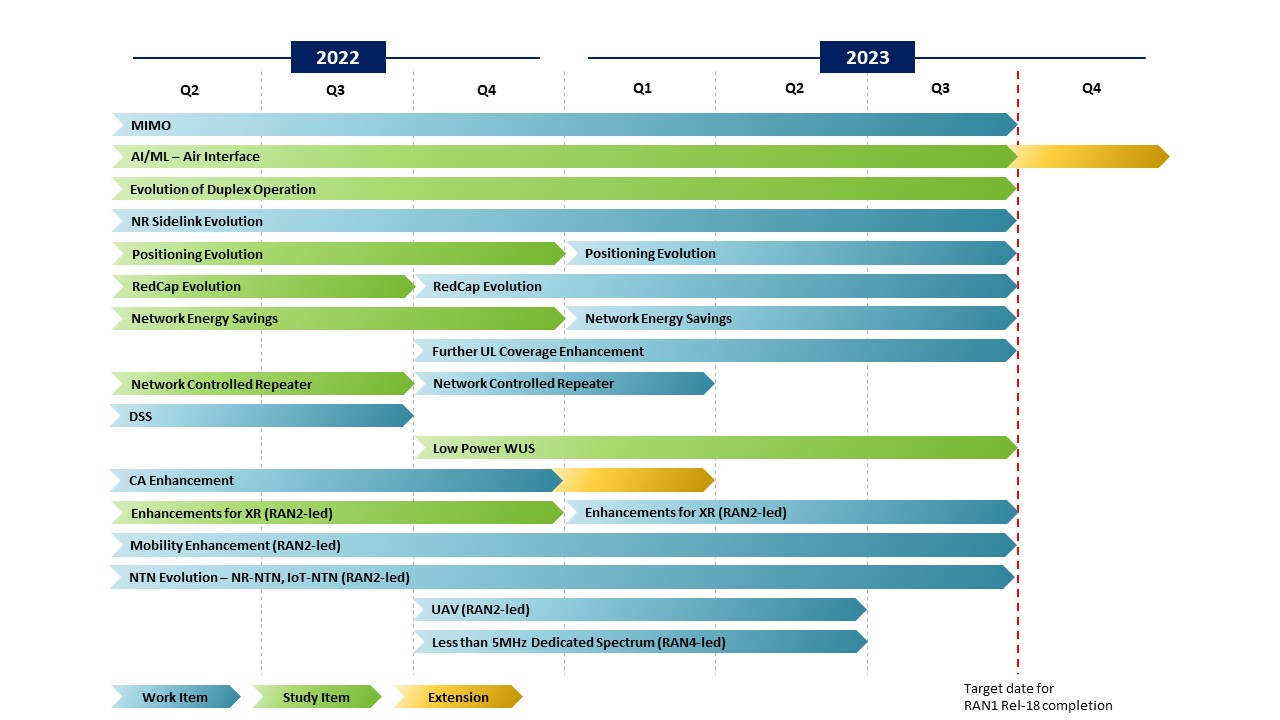
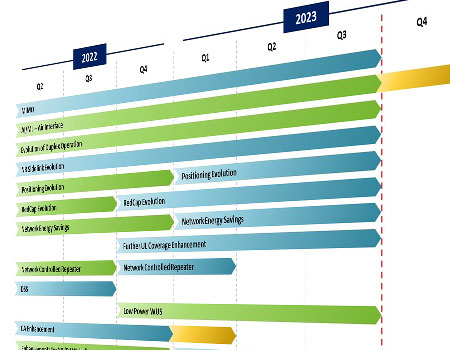
 Technology
Technology